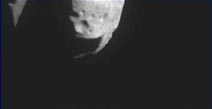
| Bad Astronomy |
|
|
|
BA Blog
|
|
Q & BA
|
|
Bulletin Board
|
| Media |
|
|
|
Bitesize Astronomy
|
|
Bad Astro Store
|
|
Mad Science
|
|
Fun Stuff
|
| Site Info |
|
|
|
Links
|
| RELATED SITES |
| - Universe Today |
| - APOD |
| - The Nine Planets |
| - Mystery Investigators |
| - Slacker Astronomy |
| - Skepticality |
Buy My Stuff

Keep Bad Astronomy close to your heart, and help make me
filthy rich. Hey, it's either this or one of those really
irritating PayPal donation buttons here.
Visit to a (very) Small Planet
Week of June 30, 1997When I was a kid-- heck, when I was in graduate school-- asteroids weren't much more than a spot of light on a photograph. Then clever people figured out how to get images of asteroids using radar, and for the first time we got an idea of what they really looked like (not counting the moons of Mars, Jupiter and the other outer planets, which we assumed looked like asteroids).

But things have changed. The Galileo spacecraft flew past two asteroids, Ida and Gaspra, and returned amazing close up images. It was even revealed that Ida had a small moon! Galileo was built to go into orbit around Jupiter, and has for the past several months returned stunning images of the planet and its bizarre moons. However, it was not specifically designed to look at asteroids.

But the Near-Earth Asteroid Rendezvous (NEAR) spacecraft was. It will rendezvous with the asteroid Eros in February of 1999. To whet our appetite, though, NEAR flew past the asteroid Mathilde on June 27. Mathilde is roughly 60 kilometers across, and reflects only about 4% of the light that hits it. That makes it one of the blackest objects ever seen in the solar system; darker than charcoal! The picture seen here shows the first close up image of Mathilde taken by NEAR. It only shows a small part of the asteroid, but it does show that Mathilde has been battered considerably more than scientists expected. The large impact crater seen at the bottom is about 20 kilometers across. For comparison, the image at the top of the page shows the relative sizes of some other asteroids.
Over 500 images of Mathilde will be returned during the encounter. If you want to see more images and learn more about NEAR, check out the sites below:
- More NEAR info can be found at the Johns Hopkins NEAR page.
- JHU also has a nice overview (including a map of the orbit) of the NEAR mission.
- Dr. Lucy McFadden has a page that describes Mathilde, which is where I got the image comparing the asteroids.
|
|
| THE PANTRY: ARCHIVE OF BITESIZE SNACKS |
|
|
| Subscribe to the Bad Astronomy Newsletter! |
| Talk about Bad Astronomy on the BA Bulletin Board! |